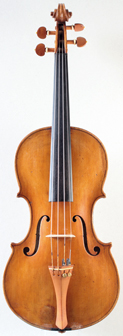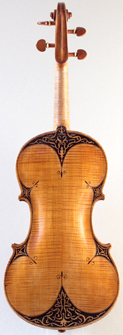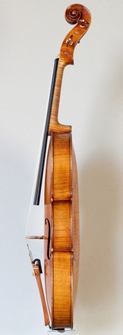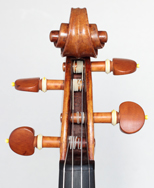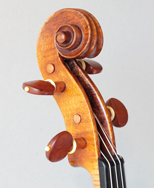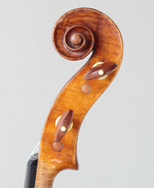Violin by Giuseppe Sgarbi, Finale Emilia, Italy, 1853
|
|
|
| |||||||||||||||
Description — Seductive
Where to start to describe such a stupendous violin?
The level of sophistication in the
choice of finest tonewood,
personal model,
unique arching,
soundhole design,
and of course the astounding inlaid decorations, lift this violin onto another artistic plane.
I feel deference towards this violin, aware that much of its intricacies go way above my head.
Just think of the time it took to
imagine the inlay,
draw it,
cut it into ebony and the matching inner pieces of wood, and
then insert it into the back with precisely the right
thickness and curve to fit the arch.
I don't know how Giuseppe Sgarbi did it.
A fascinating part of this violin is the different belly and back arching.
Both have a high and full arch,
but while the belly's rises gently from the middle bouts to a curved summit,
the back's rises steeply and takes a tight turn onto a flat longitudinal central area.
At the upper and lower bouts, the back slopes in full, round curves
that fill the circles drawn by the inlay.
It's the stylized three-dimensional sculpture of a woman's back.
Following on this analogy, the varnish, beautifully integrated into the wood
(as if it grew on it), looks like human skin of Italian tone. Letting one's mind wander,
the decorations can evoke Italian lustrous hair, or black lace, or tattoos, or your wildest fantasy.
Tone — Takes Hold of You
The first note grabs you, straight to the heart,
and the violin doesn't let go of you.
It's kind of a "booming" effect over the whole tessitura.
Each note you play,
with its instantaneous whoosh, clean response, sheer volume, and poetry hits you passionately.
Something truly unique to this Sgarbi, is the lack of edge in the sound.
The piercing overtones that can make typical violins sound shrill are simply absent,
replaced by velvet. It's ideal to play violin-piano sonatas.
The tone beauty, based on the [u:] vowel, is mesmerizing,
expressing the darkness of pain as well as the joy of revelation.
Playing this violin is a sensory experience one can't forget.
As in contemplative meditation, one just wants to enjoy and be thankful for such a blessing.
Maker — Patriotic

The label translation reads, "GIUSEPPE SGARBI N.8
nicknamed Favino
made in Finale di Modena his Motherland, on Year 1853."
I've been surprised at how little is known of Giuseppe Sgarbi's life and work.
Reference authors appear to have been copying each other, concurring on the following:
- "preferred a flat model" (Lütgendorff, 1922)
- "nicknamed Jarino" (Vannes, 1951)
- "wood not always well chosen" (Hamma, 1964)
- "red-brown varnish" (Nicolini, 2008)
- "rather careless workmanship and design" (Dilworth, 2012).
Strings — Setting Her Free
The optimal strings enter into the violin's natural resonances, both tonally and volume-wise.
It's the violin you should hear, not the strings.
Too much tension on the bridge
and it sounds like the strings are trying to impose a big tone on the poor instrument
who shuts down in reaction.
Too little tension and it feels like the violin's full potential is out of reach.
Then a string brand can sound sweet on a given violin, because they bring out its inner sweetness,
and bitter on another.
The same is true for bows, and all parts of the setup for that matter (bridge, soundpost, etc.).
On this Sgarbi, for now, I'm playing the standard combination of Thomastik Dominant strings
with Lenzner Goldbrokat E.
Their light weight and round tone liberate its essence and power.
You don't pressure the sound out of this Sgarbi, you let her sing.
Bibliography
More about this Violin:
- "On the Borders of Greatness" on TheStrad.com by Lorenzo Frignani,
The Strad, January 2020, vol. 131,
no. 1557, illustrated on page 57.

- The
Cozio Archive on Tarisio.com, violin number 55596.

- "Fine Musical Instruments" by Phillips Auctioneers, auction catalog, London,
13 November 2000, illustrated on page 34.

- W. E. Hill & Sons Business Records, violin number B147.
- "Italian Violin Makers" by Walter Hamma, 1964, 8th edition by Messiah Enterprise, 2005,
pages 512-514.

- "Liuteria Italiana dell'Ottocento e del Novecento" by Umberto Azzolina,
Casa Editrice Ceschina, Milano,
1964, page 46 & table 69.

- "Liuteria Moderna in Emilia-Romagna" by Artemio Versari, Edizioni Il Salabue, Torino,
2002, pages 170-171 & 291.

- "Conoscere la Liuteria -
II Campania e Lazio" by Raffaella Lucci & Rodolfo Marchini,
Edizioni Il Salabue, Torino,
2006, pages 108-111 & 243.

- "Italian & French Violin Makers" by Jost Thöne, volume 3, Jost Thöne,
Hachenburg, Germany, 2006, pages 79-86.

- "Liuteria Italiana 1860-1960 - I Emilia Romagna" by Eric Blot, Eric Blot Edizioni, Cremona, second edition, 2003, page 260.
- "Giuseppe Sgarbi", The Strad, May 1948, vol. 59,
no. 697, pages 6-7.

- Brompton's Fine & Rare Instruments about Giuseppe
Sgarbi.

- The Cozio Archive about Giuseppe Sgarbi on
Tarisio.com.

- "The Brompton's Book of Violin and Bow Makers" on Amati.com by John Dilworth, Ed. John Milnes, London, 2012, page 555.
- Violin by Giuseppe Sgarbi, 1853, number 7, on
InglesHayday.com.

- Viola by Giuseppe Sgarbi, 1880, on
BishopStrings.com.

- Violin by Giuseppe Sgarbi, c.1885, on
HarrisonFrankFoundation.com.

- Violin by Giuseppe Sgarbi on
Bromptons.co.

- "Violinmakers in Italy - From the 19th Century to the Present" by Gualtiero Nicolini, Alberto Perdisa Editore, Bologna, 2008, page 824.
- "Universal Dictionary of Violin and Bow Makers" by William Henley, Amati Publishing Ltd, Tunbridge Wells, England, 1973, reprinted 1997, page 1060.
- "Die Geigen- und Lautenmacher vom Mittelalter bis zur Gegenwart" on Archive.org by Willibald von Lütgendorff, volume 2, Frankfurter Verlags-Anstalt, Frankfurt am Main, Germany, third edition, 1922, page 464.
- "Dictionnaire Universel des Luthiers" by René Vannes, volume 1, Les Amis de la Musique, Brussels, second edition, 1951, page 331.
Measurements & Data
Maker: Giuseppe "Favino" Sgarbi (1818-1905)
Made in: Finale Emilia (Modena), Emilia-Romagna, Italy
Year: 1853
Number: 8
Back Length: 359 mm *
Upper Bouts: 170 mm *
Middle Bouts: 113 mm *
Lower Bouts: 210 mm *
Stop Length: 195 mm
Rib Height at Neck: 29.5 mm *
Rib Height at Endpin: 31 mm *
Thickness of the Top: 3.0 mm
Thickness of the Back: 4.6 mm
F-hole Length: 79.7 mm *
Distance Between F-holes: 39.5 mm *
Distance Edge-Purfling: 3 - 3.5 mm
Scroll Width: 41.5 mm *
Weight: 403 grams
Label:
GIUSEPPE SGARBI N.8
detto Favino
fece in Finale di Modena
sua Patria, l' Anno 1853 .
Label Translation:
GIUSEPPE SGARBI N.8
nicknamed Favino
made in Finale di Modena
his Motherland, on Year 1853 .
Inlay: Ebony foliate inlay on the back at the upper bout from the button down, at the four corners, and at the lower end; also around the endpin.
Condition: Very good for its age. Overall only a couple of minor cracks and a broken edge. The back is pristine. Neck and pegbox were replaced.
Certificate:
Eric Blot, Cremona, Italy, 2006.
D. R. Hill & Son, Little Missenden, England, 2016.
* measured with a caliper
Maker: Giuseppe "Favino" Sgarbi (1818-1905)
Made in: Finale Emilia (Modena), Emilia-Romagna, Italy
Year: 1853
Number: 8
Back Length: 359 mm *
Upper Bouts: 170 mm *
Middle Bouts: 113 mm *
Lower Bouts: 210 mm *
Stop Length: 195 mm
Rib Height at Neck: 29.5 mm *
Rib Height at Endpin: 31 mm *
Thickness of the Top: 3.0 mm
Thickness of the Back: 4.6 mm
F-hole Length: 79.7 mm *
Distance Between F-holes: 39.5 mm *
Distance Edge-Purfling: 3 - 3.5 mm
Scroll Width: 41.5 mm *
Weight: 403 grams
Label:
GIUSEPPE SGARBI N.8
detto Favino
fece in Finale di Modena
sua Patria, l' Anno 1853 .
Label Translation:
GIUSEPPE SGARBI N.8
nicknamed Favino
made in Finale di Modena
his Motherland, on Year 1853 .
Inlay: Ebony foliate inlay on the back at the upper bout from the button down, at the four corners, and at the lower end; also around the endpin.
Condition: Very good for its age. Overall only a couple of minor cracks and a broken edge. The back is pristine. Neck and pegbox were replaced.
Certificate:
Eric Blot, Cremona, Italy, 2006.
D. R. Hill & Son, Little Missenden, England, 2016.
* measured with a caliper



